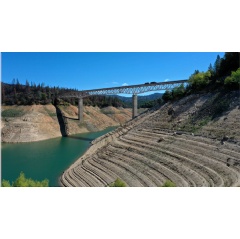Climate attribution tools critical for understanding extreme events
New research examines climate influence on extreme events in 2021 and 2022

A combination heat and drought event in the western U.S., simultaneous ocean and land heat waves in the northwestern region of the Pacific Ocean, a South Korean heat wave that was off the charts and wildfires in Cape Town, South Africa, were some of the recent extreme weather events made more likely by human-caused climate change, according to new research offsite link posted today on the Bulletin of the American Meteorological Society (BAMS) website.
Now in its 11th year, Explaining Extreme Events from a Climate Perspective presents new peer-reviewed analyses of extreme weather and climate across the world during 2021 and 2022. It features research from NOAA and other leading international climate scientists on extreme weather occurring across the globe, including the U.S., U.K., South Korea and China. Research teams use both historical observations and model simulations to determine whether — and by how much — climate change may have influenced particular extreme weather events.
“These studies contextualize recent extreme events, explaining how the risk for them is changing in time, and highlighting how climate change is making them more likely or severe,” said NOAA Chief Scientist Sarah Kapnick, Ph.D. “By helping quantify these evolving risks and what is causing them, we can help communities plan and prepare for the future with a better sense of what lies ahead.”
“A key finding emerging both from this new research in BAMS and elsewhere in the scientific literature is that extreme heat events are increasingly far outside the historical record because of climate change, which has implications for risk assessment,” explained Stephanie Herring, climate scientist at NOAA’s National Centers for Environmental Information and one of the report’s editors. “To better understand what we might be facing in the future, we need to continue to research how these events are changing over time and consider the possibility that we are underestimating future risk.”
One study found that South Korean average temperature during October 2021 was almost 7 degrees Fahrenheit higher than the average observed between 1991-2020, which corresponds to a one-in-6,250 year event. However, the climate model used in the study projected that this kind of heat wave could become a new normal in South Korea by 2060 “without ambitious cuts to greenhouse gas pollution.”
[p"The extreme nature of these events is very alarming,” Herring said. “We need to understand if these events are signs that things are getting hotter faster than we had expected. We know extreme heat is going to get worse, and additional research will help us better quantify future change.”[/p]Co-located events — previously only studied in isolation — were also examined, showing that the risk of multiple perils happening at the same time is also changing. For example, one paper studied the 2021 marine and terrestrial heat wave that affected people, commerce, infrastructure and marine fisheries throughout Asia, including Japan, Korea and China. The chances of such an event are 30 times more likely today due to climate change, and likely to happen every 1.5 years by the middle of the century under high greenhouse gas emissions scenarios.
Additional findings from some of the climate attribution research published in this report illustrate the ways climate change has influenced extreme events.
Drought
- Climate change and a strong La Niña combined to generate a six-fold increase in the risk of extreme drought, compounded by high temperatures over an extended period, as observed in California and Nevada from October 2020 to September 2021.
- One study found that severe, long-lasting drought like that experienced by Iran in 2020 and 2021 is now 50% more likely, mainly due to greenhouse-gas driven warming.
Heat
- Anthropogenic (human-induced) warming made the probability of the record-breaking winter hot spell experienced in East Asia in February 2021 between 4 and 20 times more likely.
Fire
- Climate models suggest that extreme weather associated with the April 2021 Cape Town wildfire has become 90% more likely in a warmer world.
Heavy precipitation & flooding
- Extreme rainfall experienced in the U.K. in May 2021 was 1.5 times more likely due to anthropogenic climate change. Persistent low pressure also contributed to the rains.
Agricultural impacts
- Persistent cloudiness over the southeastern Tibetan Plateau was severe enough to reduce vegetation growth. A study attributed the event to abnormally strong southerly winds, pollution and greenhouse gas-induced warming.
The new research also includes a perspective article discussing how climate attribution science can support informed decision-making for water resource managers to prepare for future droughts.
“Human-caused climate change is an extreme disruption of the Earth system,” said Paul Higgins, Associate Executive Director of the American Meteorological Society. “We should expect it to lead to more extreme events, as this new research helps to show. We must do what we can to help people, and all life, thrive in spite of this danger.”
The extreme weather events studied in the Explaining Extreme Events series were selected by individual researchers as a way to investigate the utility and skill of climate attribution analytical methods. They do not represent a comprehensive analysis of events over the 2011-2021 period. Over 80% of the more than 200 research findings published in this series identified a substantial link between an extreme event and climate change.
To learn more, visit the Explaining Extreme Events webpage.
IMAGE CAPTION:
New NOAA research published in the Bulletin of the American Meteorological Society finds that the extreme heat and drought experienced by California and Nevada from October 2020 to September 2021 was made six times more likely by climate change. This photo of Lake Oroville, California, in April 2021 reflected the severity of water shortages across the region that year. (Lake Oroville, California: April 2021)
( Press Release Image: https://photos.webwire.com/prmedia/8/299028/299028-1.png )
WebWireID299028
This news content was configured by WebWire editorial staff. Linking is permitted.
News Release Distribution and Press Release Distribution Services Provided by WebWire.